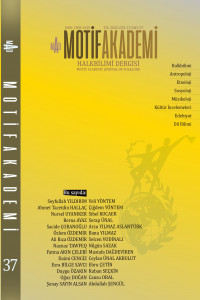Abstract
Hz. Muhammed’in merkezinde, Hz. Ali’nin ise başkahraman olduğu cenknâmeler anlatı geleneğimizde önemli bir yere sahiptir. İslamiyet’i kabul eden Türkler için Gök Tanrı adına cihan hakimiyetini sağlama ülküsü Allah’ın adını yaymak için gaza anlayışına dönüşmüştür. Bu durum edebi geleneğe ve zevke de yansımıştır. Cenknâmeler dinî ve ahlâkî mesajlar vermekle birlikte Hz. Ali özelinde idealize edilen bir tipi de ortaya koymaktadır. Bilindiği gibi Hz. Ali, Hz. Muhammed’in damadı, amcasının oğlu ve dördüncü halifesidir. Cenknâmelerde Hz. Muhammed ve Ehl-i Beyt sevgisi açıkça görülür. Hz. Ali, cesur, savaşçı, güçlü, adaletli, zekidir. Kâfirlerle olan savaşlarında her daim kazanmaktadır. Hz. Ali, cenknâmelerde kafirlerin dışında dev, ejderha, ifrit gibi efsanevi ve mitolojik varlıklarla da savaşır. Bu çalışmanın konusunu oluşturan cenknâme, Ankara Millî Kütüphane Yazma eserler koleksiyonunda 06 Mil Yz A 1454/3 arşiv numarası ile kayıtlıdır. Ana eser, Dâstân-ı Muhammed Hanefî (1a-18a), Dâstân-ı Kesikbaş (19b-22b), Hikâyet-i Hazreti ǾAişe (23a-36b) ve Dâstân-ı Kız (37b-441) başlıklı dört ayrı mesneviden oluşmaktadır. 13 varaktan oluşan üzerinde çalışılan kısım bu yazmadaki üçüncü mesnevi olup harekeli Nesih hatla kaleme alınmıştır. Eserin yazılış tarihi ve müellifi ile ilgili kesin bir bilgi yoktur. Fakat 32a numaralı varağın en alt kısmında temellük kaydı olduğunu düşündüğümüz H. 1187 (M. 1773-74) tarihi ve ... Mehmed Ağa ibareleri kayıtlıdır. Çalışmada öncelikle cenknâmeler hakkında bilgi verilecek ardından ise nüshanın tanıtımı yapılacaktır. Metinde yer alan kahraman tipi olarak Hz. Ali ile kötülüğün temsilcisi olan İfrit değerlendirilecektir.
Keywords
References
- Aykaç, O. (2017). Hz. Ali-İfrit cenginin yeni bir nüshası. Alevilik Araştırmaları Dergisi, S. 17, 31-69.
- Boratav, P. N. (1982). Folklor ve edebiyat 1. İstanbul: Adam.
- Çetin, İ. (1997). Türk edebiyatında Hz. Ali cenknâmeleri. Ankara: Kültür Bakanlığı.
- Çetin, İ. (2002). Tursun Fakih (Hayatı-edebî şahsiyeti-mesnevîleri). Ankara: İlesam.
- Erbaş, A. (2000). İfrit. İslam Ansiklopedisi. C. 21, İstanbul.
- Kaplan, M. (2004). Türk edebiyatı üzerinde araştırmalar 3 tip tahlilleri. 5. b., İstanbul: Dergâh.
- Köprülü, M. F. (2004). Edebiyat araştırmaları 1. Ankara: Akçağ.
- Levend, A. S. (1968). Divan edebiyatında hikâye I. TDAY Belleten, 1967, 98-115.
- Uyanıker, N. (2014). Manzum dînî-kahramanlık hikayeleri bağlamında Hz. Ali ile Kahkaha Sultan cengi. Divan Edebiyatı Araştırmaları Dergisi, 12, 191-227.
- Ünlüsoy, K. (2017). Anadolu’da Hz. Ali tasavvurları (XIII. XVI. yüzyıllar). Ankara: Türk Tarih Kurumu.
Abstract
Cenkname where Ali is the protagonist has a key role in our narrative tradition, within the life of the Prophet Muhammed. For the Turks who accepted Islam, the ideal of providing world domination in the name of the Tengri has turned into an understanding of holy war in order to spread the name of Allah. This case has also been reflected in literary tradition and appreciation. Cenknâme gives religious and moral messages, Ali also reveals a type that is idealized specifically. As is known, Ali, Muhammad's son-in-law, is his uncle's son and fourth caliph. In Cenknâme, the Prophet Muhammad and the love of Ahl al-Bayt (People of the House) are clearly seen. Ali is brave, warrior, strong, fair, intelligent. He always wins in his battles with the infidels. Ali also fights legendary and mythological beings such as giants, dragons, and afreets besides infidels. Cenkname constituting the subject of this study is recorded in Ankara National Library Writing Works Collection with 06 Mile Yz A 1454/3 archive number. The main work consists of four separate mesnevi titled Dâstân-ı Muhammed Hanefî (1a-18a), Dâstân-ı Kesikbaş (19b-22b), Hikâyet-ı Hazreti (23a-36b) and Dâstân-ı Kız (37b-441). The section consisting of 13 gold leaves is the third mesnevi in this article and was written with a mobile Nesih line. There is no definitive information related to the date of writing and the author of the work. However, the bottom of the gold leaf no. 32a has the records of H. 1187 (M. 1773-74) date and Mehmed Ağa phrases, which we believe that they have acquisition records. In the study, information will be given about the cenknâme first and then the copy will be introduced. As the hero type in the text, Ali and Efreet, the representative of evil, will be evaluated.
Keywords
References
- Aykaç, O. (2017). Hz. Ali-İfrit cenginin yeni bir nüshası. Alevilik Araştırmaları Dergisi, S. 17, 31-69.
- Boratav, P. N. (1982). Folklor ve edebiyat 1. İstanbul: Adam.
- Çetin, İ. (1997). Türk edebiyatında Hz. Ali cenknâmeleri. Ankara: Kültür Bakanlığı.
- Çetin, İ. (2002). Tursun Fakih (Hayatı-edebî şahsiyeti-mesnevîleri). Ankara: İlesam.
- Erbaş, A. (2000). İfrit. İslam Ansiklopedisi. C. 21, İstanbul.
- Kaplan, M. (2004). Türk edebiyatı üzerinde araştırmalar 3 tip tahlilleri. 5. b., İstanbul: Dergâh.
- Köprülü, M. F. (2004). Edebiyat araştırmaları 1. Ankara: Akçağ.
- Levend, A. S. (1968). Divan edebiyatında hikâye I. TDAY Belleten, 1967, 98-115.
- Uyanıker, N. (2014). Manzum dînî-kahramanlık hikayeleri bağlamında Hz. Ali ile Kahkaha Sultan cengi. Divan Edebiyatı Araştırmaları Dergisi, 12, 191-227.
- Ünlüsoy, K. (2017). Anadolu’da Hz. Ali tasavvurları (XIII. XVI. yüzyıllar). Ankara: Türk Tarih Kurumu.
Details
| Primary Language | Turkish |
|---|---|
| Subjects | Turkish Folklore |
| Journal Section | Articles |
| Authors | |
| Publication Date | March 16, 2022 |
| Submission Date | February 15, 2022 |
| Published in Issue | Year 2022 Volume: 15 Issue: 37 |

